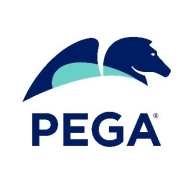

Pega Platform and Nintex Process Platform compete in the business process management category. Pega has the upper hand due to its rapid development capabilities and strong case management features, while Nintex is noted for its ease of workflow creation and user engagement.
Features: Pega Platform offers fast prototyping, a no-code environment tailored to enterprise needs, and robust case management and integration capabilities. Nintex Process Platform excels with its intuitive drag-and-drop interface, compatibility with Visual Studio and SharePoint Designer, and ease of developing workflows.
Room for Improvement: Pega needs to address cost concerns, upgrade complexity, integration options, AI capabilities, and UI flexibility. Nintex could improve error reporting, integration capabilities, and enhance mobile and AI offerings while addressing setup complexity and pricing issues.
Ease of Deployment and Customer Service: Pega offers various deployment options, including public cloud and hybrid models, yet needs more responsive customer support. Nintex focuses on on-premises solutions with limited cloud options, and similar improvements in customer service responsiveness would be beneficial.
Pricing and ROI: Pega is perceived as high-priced but delivers clear ROI through efficiency and rapid market deployment. Nintex offers competitive pricing, although it can become costly with subscription models, yet both platforms demonstrate tangible ROI.
The technical support from Pega is very low, rating a one or two out of ten.
I never needed support from the platform standpoint, but if additional features are required, we have regular meetings with the product team for feedback.
Pega's technical support team is very helpful.
Currently, big banking providers and insurance providers, even the members for healthcare payers, are using more than millions of operations on a daily or weekly basis.
Additionally, the deployment process should be easier.
With the recent development of AI agents in Pega Platform 24.2, the adoption is not heavy due to regulations around using external LLM by customers, especially regulated customers in BFSS and healthcare.
Pega introduced Constellation, which allows a user to build a more engaging visual experience.
My learning curve in robotics has been challenging.
Nintex Process Platform is expensive.
The pricing is expensive, and this is an issue.
Pega is priced higher than open-source options like Flowable but is suitable for large-scale industries like banking and insurance.
From a licensing perspective, it is higher than the competition.
My team and I created a demo using Nintex, focusing on getting emails, reading, writing, and managing attachments.
Pega Platform is excellent for enterprise-level solutions with integrations to entire systems, including case management, service orchestration, CRM, decision-making capabilities, digital process automation, and AI-driven functionalities.
Management capabilities such as dashboards.
| Product | Market Share (%) |
|---|---|
| Pega Platform | 5.0% |
| Nintex Process Platform | 1.8% |
| Other | 93.2% |


| Company Size | Count |
|---|---|
| Small Business | 17 |
| Midsize Enterprise | 6 |
| Large Enterprise | 24 |
| Company Size | Count |
|---|---|
| Small Business | 9 |
| Midsize Enterprise | 15 |
| Large Enterprise | 68 |
Nintex Process Platform offers no/low-code development with system integrations and efficient workflow management, ideal for complex business processes. It's known for its scalable workflows, data management through SmartObjects, and a user-friendly visual designer.
Nintex Process Platform enables organizations to automate processes with ease, supporting electronic forms, digital transformation, and seamless department collaboration. Users on SharePoint and other integrated systems leverage its extensive workflow capabilities for approvals, onboarding, and information capture. While its current framework might benefit from performance enhancements and improved management console usability, it remains a strong choice for providing scalable solutions across industries.
What are the key features of Nintex Process Platform?Companies in sectors like government, HR, and financial services implement Nintex Process Platform for its ability to streamline and connect internal processes. It supports approval workflows, notifications, and data capturing, proving its versatility for diverse business needs. However, challenges with document conversion, performance, and cloud feature parity suggest room for enhancements, particularly in industries handling complex workflows.
Pega Platform provides flexible business process management with a focus on rapid application development and automation through a low-code approach, enhancing efficiency across sectors.
Pega Platform is renowned for its ability to streamline operations with robust automation features, including robotic process automation and decision-making capabilities. Its intuitive interface and workflow management contribute to a reputation for enhancing business processes. Although users face challenges with integration limitations and high licensing costs, they benefit from rapid deployment and efficient process adaptations. The unified architecture reduces complexity, while case management and integration services support digital transformations in sectors such as banking, insurance, and healthcare.
What are the key features of Pega Platform?In industries like insurance, banking, healthcare, and government, Pega Platform is implemented to automate diverse workflows, supporting initiatives from claims processing to customer onboarding. Enterprises use Pega for case management and digital transformations, valuing its out-of-the-box integrations and real-time reporting capabilities to boost operational automation and enhance customer experiences.
We monitor all Business Process Management (BPM) reviews to prevent fraudulent reviews and keep review quality high. We do not post reviews by company employees or direct competitors. We validate each review for authenticity via cross-reference with LinkedIn, and personal follow-up with the reviewer when necessary.